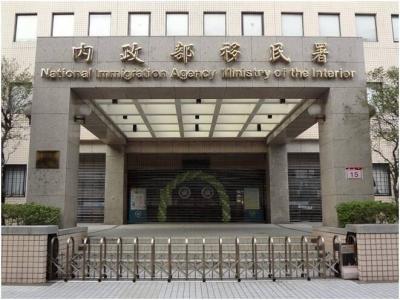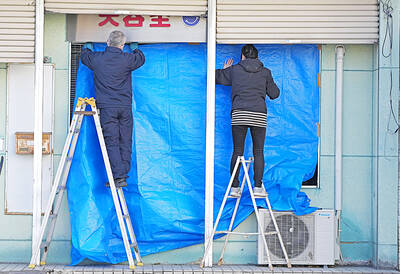A team led by National Cheng Kung University (NCKU) physicists yesterday announced a major breakthrough regarding a next-generation memory storage material that is expected to multiply the efficiency of memory units and pave the way for quantum technology development.
Traditional memory devices process information based on two logic states — zero and one — while their efficiency can be improved only by increasing the density of components and reducing their size, department of physics assistant professor Yang Jan-chi (楊展其) said.
To eliminate the bottleneck in memory development, the team turned to an alternative material — bismuth ferrite (BiFeO3), a material that can record eight logic states and keep the stored information for up to a year even when it is not powered or is heated up to 400°C, Yang said.

Photo: Chien Hui-ju, Taipei Times
The main breakthrough involves controlling the material through laser illumination, which helps reduce delays in the reading of data and energy consumption, while boosting calculation efficiency, he said.
No other researchers have attempted to control high-density memory material using optical means, he said.
Yang, 32, is also enrolled in a Ministry of Science and Technology young talent cultivation program.
The development of BiFeO3 largely remains at the level of academic research and the team has found that the light-driven flexoelectric effect is key to its manipulation, professor Chen Yi-chun (陳宜君) said.
As light presents alternating electromagnetic fields, it is seldom used to control the operations of memory materials, she said.
Nonetheless, the team found that the material’s operations could be manipulated when placed on a surface whose strain gradient is slightly altered by illumination, she said.
The findings were detailed in a paper titled “Deterministic optical control of room temperature multiferroicity in BiFeO3 thin films,” published in the journal Nature Materials on May 6.
The team submitted the manuscript in July last year and it was accepted in March, Chen said.
The team expressed gratitude to collaborators at Hsinchu-based National Synchrotron Radiation Research Center and National Chiao Tung University, as well as members from Germany’s Max-Planck Institute for Chemical Physics of Solids, the University of Texas at Arlington and Lawrence Berkeley National Laboratory, and the University of New South Wales.
While more time is needed before the technology becomes commercially applicable, its discovery brings the nation a step closer to quantum computing technology, which would require highly efficient calculating units, NCKU vice president for research and development Hsieh Sun-yuan (謝孫源) said.

A small number of Taiwanese this year lost their citizenship rights after traveling in China and obtaining a one-time Chinese passport to cross the border into Russia, a source said today. The people signed up through Chinese travel agencies for tours of neighboring Russia with companies claiming they could obtain Russian visas and fast-track border clearance, the source said on condition of anonymity. The travelers were actually issued one-time-use Chinese passports, they said. Taiwanese are prohibited from holding a Chinese passport or household registration. If found to have a Chinese ID, they may lose their resident status under Article 9-1

Taiwanese were praised for their composure after a video filmed by Taiwanese tourists capturing the moment a magnitude 7.5 earthquake struck Japan’s Aomori Prefecture went viral on social media. The video shows a hotel room shaking violently amid Monday’s quake, with objects falling to the ground. Two Taiwanese began filming with their mobile phones, while two others held the sides of a TV to prevent it from falling. When the shaking stopped, the pair calmly took down the TV and laid it flat on a tatami mat, the video shows. The video also captured the group talking about the safety of their companions bathing

PROBLEMATIC APP: Citing more than 1,000 fraud cases, the government is taking the app down for a year, but opposition voices are calling it censorship Chinese Nationalist Party (KMT) Chairwoman Cheng Li-wun (鄭麗文) yesterday decried a government plan to suspend access to Chinese social media platform Xiaohongshu (小紅書) for one year as censorship, while the Presidential Office backed the plan. The Ministry of the Interior on Thursday cited security risks and accusations that the Instagram-like app, known as Rednote in English, had figured in more than 1,700 fraud cases since last year. The company, which has about 3 million users in Taiwan, has not yet responded to requests for comment. “Many people online are already asking ‘How to climb over the firewall to access Xiaohongshu,’” Cheng posted on

A classified Pentagon-produced, multiyear assessment — the Overmatch brief — highlighted unreported Chinese capabilities to destroy US military assets and identified US supply chain choke points, painting a disturbing picture of waning US military might, a New York Times editorial published on Monday said. US Secretary of Defense Pete Hegseth’s comments in November last year that “we lose every time” in Pentagon-conducted war games pitting the US against China further highlighted the uncertainty about the US’ capability to intervene in the event of a Chinese invasion of Taiwan. “It shows the Pentagon’s overreliance on expensive, vulnerable weapons as adversaries field cheap, technologically